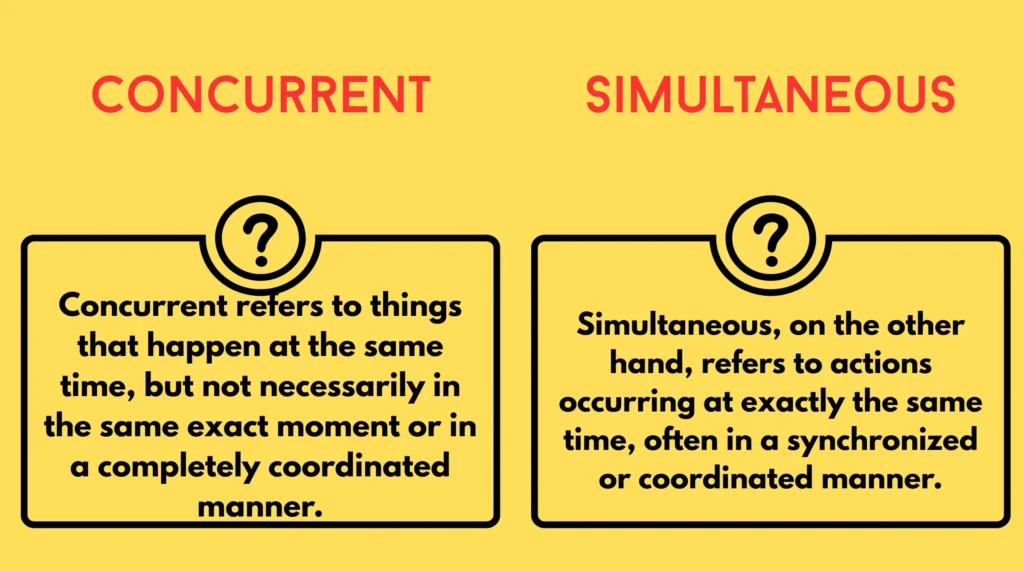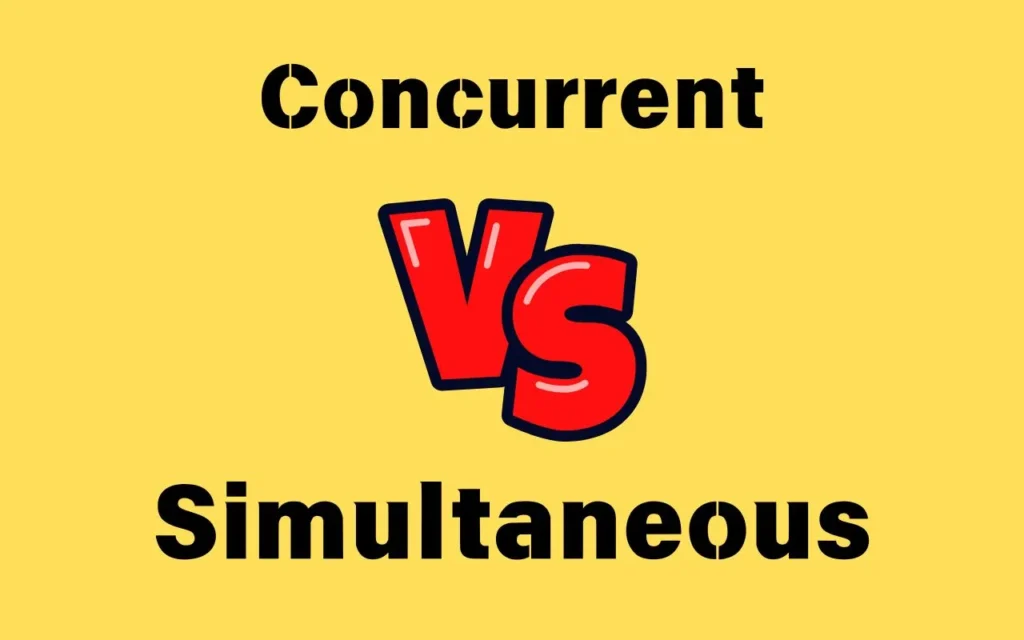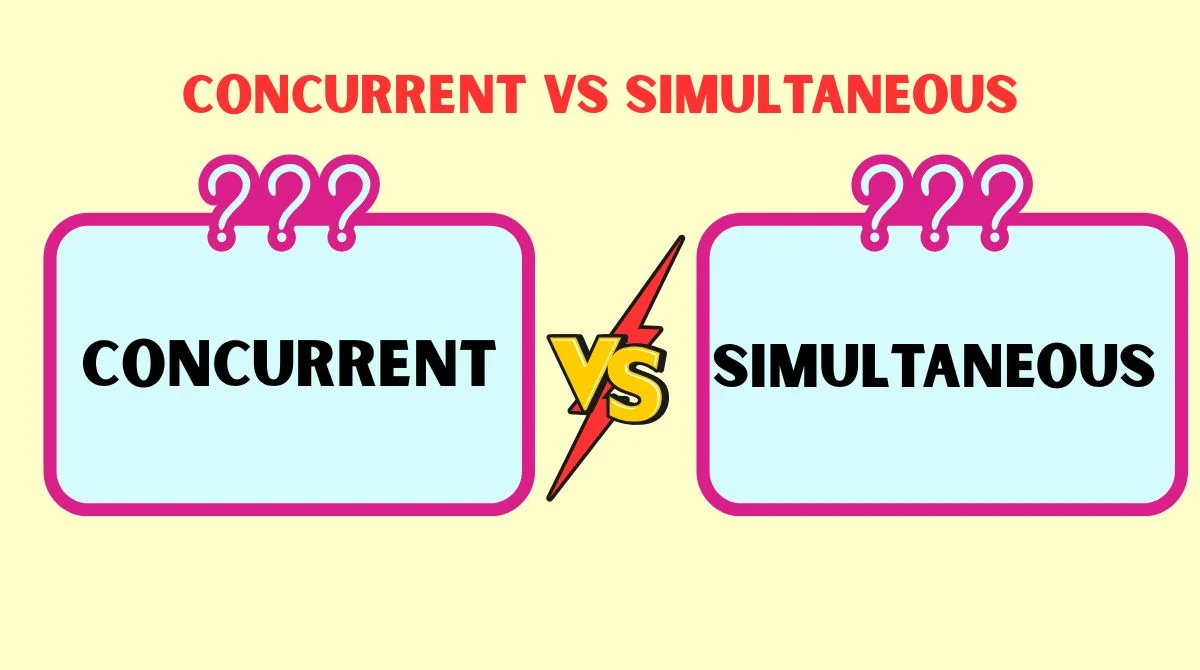Last updated on September 12th, 2025 at 05:12 pm
We often use words like concurrent and simultaneous interchangeably, assuming they mean the same thing.
However, there are subtle differences that can change the meaning, especially in technical, professional, and everyday contexts.
In this article, we’ll break down these two terms, explore their definitions, and help you understand when to use each one to communicate clearly and accurately.
Understanding the Basics: Concurrent and Simultaneous Defined

At their core, both concurrent and simultaneous refer to actions that happen at the same time, but they are used in different contexts and have distinct nuances.
Let’s define both terms clearly before diving into the differences.
What Does Concurrent Mean?
Concurrent refers to things that happen at the same time, but not necessarily in the same exact moment or in a completely coordinated manner. It implies that multiple events or processes are happening alongside one another, often with an overlap but not necessarily synchronized.
Example:
- “The students worked on concurrent tasks during the workshop.”
In this case, the tasks happened at the same time, but each student might have been focused on a different task independently.
What Does Simultaneous Mean?
Simultaneous, on the other hand, refers to actions occurring at exactly the same time, often in a synchronized or coordinated manner.
It highlights that the events are not just overlapping—they are happening at precisely the same moment.
Example:
- “The fireworks exploded simultaneously at midnight.”
The fireworks all went off at exactly the same time, coordinated to create a visual effect.
Struggling to tell the difference between concurrent and simultaneous? This guide explains the key differences, real-life examples, and when to use each term in everyday and technical contexts.
The General Meaning of Concurrent and Simultaneous
Both words describe the idea of time overlap, but the way they are used changes the emphasis. Understanding the general meaning of each will help you choose the correct term in any context.
- Concurrent suggests that multiple things are happening during the same period but aren’t necessarily bound to the exact moment.
- Simultaneous suggests a stronger connection, where the events or actions happen in perfect synchronization.
Key Differences in General Usage:
- Concurrent is often used for situations where tasks, events, or actions are happening over a span of time, but not always at the exact same point in time.
- Simultaneous is typically reserved for situations where everything happens exactly at the same instant.
Distinguishing the Subtle Nuances
The primary difference between concurrent and simultaneous lies in their level of precision and synchronization. Let’s break it down into a few key points:
Concurrent:
- Time span: Things overlap in time but don’t need to start or end at the exact same moment.
- Asynchronous nature: The actions or events can still have independent durations.
- Contextual flexibility: Often used in professional, technological, or broader contexts.
Simultaneous:
- Exact timing: Everything occurs at the exact same moment, emphasizing perfect synchronization.
- Synchronized: Actions are tightly coordinated, usually within a very short time frame.
- Precise nature: More specific, often used in scientific or high-precision contexts.
Real-life Examples of Concurrent Actions
Let’s look at some everyday examples to better understand when concurrent actions take place. In these instances, multiple activities happen during the same time frame, but not necessarily all at once.
Example 1:
Two people reading books at the same time. While both are reading, they might be reading different books at different speeds. This is a concurrent action because both activities occur during the same period.
Example 2:
At a busy coffee shop, one person is ordering coffee while another is picking up their order. These are concurrent actions because both are happening at the same time, but they’re independent of each other.
Example 3:
An office worker might be answering emails while attending a conference call. Both tasks are occurring at the same time, but they are handled separately.
The Intricacies of Simultaneous Occurrences
On the flip side, when something is simultaneous, it means everything happens at the exact same moment, with no time difference between the actions. Here’s how you might encounter simultaneous events in everyday life:
Example 1:
The synchronized launch of multiple rockets in a space mission. All rockets are launched at the exact same moment, which makes the event simultaneous.
Example 2:
When two people clap at the same exact moment during a performance. The clapping occurs simultaneously—both people clapping at the exact same time.
Example 3:
A group of friends shouting “Surprise!” at the same instant during a birthday party. The action of shouting is simultaneous, as everyone shouts at precisely the same time.
Deciphering Concurrent and Simultaneous in a Technological Context
In technology and computing, the difference between concurrent and simultaneous becomes especially important. Let’s explore how these terms apply in the world of software and performance testing.
Interpreting Concurrent and Simultaneous Users in Performance Testing
In performance testing, concurrent users refers to users who interact with a system within the same time frame but may not be performing actions at the exact same moment. These users are often active in parallel but asynchronously.
- Concurrent users could mean 10 users browsing a website at the same time, but they may click on different links or visit different pages, performing actions at slightly different times.
In contrast, simultaneous users would imply that all 10 users are performing actions exactly at the same moment, such as pressing a button or submitting a form at the exact second.
How Software Handles Concurrent Operations
Software systems often need to handle concurrent operations. This doesn’t mean that every operation happens at the same exact time; rather, operations are processed in parallel, often via multithreading or asynchronous processing. For example, a user might upload a photo while another is browsing content on the same platform. The system processes these actions concurrently but not simultaneously.
The Impact of Context on Choosing Between Concurrent and Simultaneous
When deciding between concurrent and simultaneous, context is crucial. Consider the situation carefully before choosing a term. If you’re describing actions that happen in parallel but don’t require exact timing, concurrent is often the best choice. If the events must occur at the exact same moment, use simultaneous.
Example:
- Concurrent: “The workers are performing concurrent tasks in different parts of the factory.”
- Simultaneous: “The lights turned on simultaneously, creating a dramatic effect.”
Examining Usage Frequency: Concurrent vs Simultaneous in Everyday Language
In everyday language, concurrent is often used more frequently than simultaneous because it applies to a wider range of situations. For example, in a busy office, people may often be working on concurrent tasks. Simultaneous, on the other hand, tends to be reserved for more precise or specialized situations, such as in scientific experiments or performances where timing is crucial.
Insights from Google Ngram Viewer

Using Google Ngram Viewer, we can track the frequency of both concurrent and simultaneous over time. Concurrent has seen more consistent usage across various fields, especially in business, technology, and casual conversation.
Simultaneous, however, peaks in usage during discussions of scientific, technical, and theatrical contexts, where precise timing is necessary.
FAQs
What is the difference between ‘concurrent’ and ‘simultaneous’?
‘Concurrent’ refers to actions happening at the same time but not necessarily in sync, while ‘simultaneous’ means actions happening at the exact same moment.
Can concurrent events happen at different times?
No, concurrent events happen during the same time frame but may not occur at the same exact moment.
When should I use the word ‘simultaneous’?
Use ‘simultaneous’ when you want to describe events that happen at the exact same time, often with perfect synchronization.
Can you give examples of concurrent actions?
- Two people reading different books at the same time.
- One person ordering coffee while another picks up their order at a cafe.
What are some real-life examples of simultaneous events?
- Rockets launching at the exact same moment.
- A group of people clapping at the same time during a concert.
How are concurrent users different from simultaneous users in tech?
Concurrent users interact with a system at the same time but may not be performing actions simultaneously. Simultaneous users perform actions at exactly the same moment.
Concluding Thoughts on When to Use Concurrent vs Simultaneous
In conclusion, while concurrent and simultaneous both refer to actions occurring at the same time, the context and level of synchronization matter.
Use concurrent when events overlap in time but don’t need to happen at exactly the same moment, and choose simultaneous when timing is crucial and everything happens in perfect synchronization.
